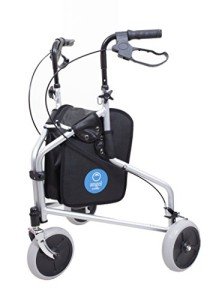Let's Get It Out Of The Way! 15 Things About How To Use A Rollator We'…
페이지 정보

본문

How To Use A Rollator: A Comprehensive Guide
Rollators are mobility aids designed to improve the independence and safety of individuals with mobility challenges. Unlike standard walkers, rollators are geared up with wheels, a seat, and typically a storage pouch, allowing users to move with greater ease and convenience. This short article supplies a thorough guide on how to use a rollator successfully and safely, making sure a smoother and more satisfying walking experience.
What is a Rollator?
A rollator is a wheeled walking aid. It generally has:
- Three or four wheels: Offering stability and maneuverability.
- Hand brakes: For control while walking or when resting.
- A seat: Allowing users to take breaks conveniently.
- Storage space: Such as a basket or pouch for personal items.
Kinds of Rollators
There are various kinds of rollators, developed to fulfill the requirements of different users:
| Type | Description | Best for |
|---|---|---|
| 3-Wheel Rollator | Lighter and more compact, perfect for indoor use | Browsing tight areas |
| 4-Wheel Rollator | Offers stability and a bigger seat, suitable for outdoor use | Longer walks and much heavier use |
| Durable Rollator | Created to support more weight with extra robust functions | Users requiring extra assistance |
| Pediatric Rollator | Smaller sized in size, adjusted for kids | Kids with mobility limitations |
How to Use a Rollator
Utilizing a rollator correctly is important to ensure safety and take full advantage of the benefits it provides. Here's a step-by-step guide:
Step 1: Adjust the Height
Before using the rollator, it is necessary to adjust the handlebars to the right height.
- Stand directly: With your arms relaxed at your sides.
- Step the height: The hand grips need to be at wrist level when the user is standing.
- Safe and secure modifications: Ensure all locking systems are securely engaged.
Action 2: Familiarize Yourself with the Rollator
Understanding the parts of the rollator will help improve its functionality.
- Brakes: Learn how to engage and release the brakes by squeezing the handles.
- Seat: Identify where to sit conveniently when you need to rest.
- Storage area: Know where you can keep personal belongings.
Step 3: Start Walking
- Position the rollator: Place it a step ahead of you, guaranteeing that the brakes are launched.
- Grip the manages firmly: Keep a light tension in your arms while keeping the rollator.
- Step inside the frame: Move forward by stepping with one foot and then the other.
- Maintain a straight posture: Walking ought to be upright, preventing the temptation to lean on the rollator exceedingly.
Step 4: Utilize Brakes
Always use the brakes successfully to improve safety:
- To decrease: Gradually squeeze the brakes.
- To stop: Fully engage the brakes by pulling on both manages.
- To sit down: Ensure the rollator is stable, then thoroughly lower yourself onto the seat.
Step 5: Maneuver with Care
Turning and browsing can be tough, so here are necessary pointers:
- Telegraph your direction: Look where you want to precede turning.
- Take small steps: Move gently when turning to preserve balance.
- Use a three-point turn: Turn from one side to the other, keeping the walker close.
Step 6: Practice Stopping and Resting
Taking breaks is vital. Here are ideas for resting:
- Find flat surface areas: Ensure the location is level when you sit.
- Engage the brakes when seated: This will prevent rolling.
- Shift position gradually: When prepared to stand once again, remove the brakes before rising.
Upkeep and Safety Tips
To make sure the rollator stays functional and safe:
- Regularly examine the brakes: Ensure they engage and launch properly.
- Check wheel alignment: Wheels ought to not wobble; tighten up any loose screws.
- Clean the rollator: Wipe down surfaces and get rid of debris from tires to preserve smooth operation.
Common Concerns
Users may face a number of common problems when using rollators. Here are some basic FAQs:
FAQs
Q1: Can I use a rollator outdoors?A: Yes, most
rollators are created for both indoor and outdoor use. Nevertheless, ensure it has the proper wheel size and tread for outdoor surface areas. Q2: What are the weight limitations on rollators?A: Weight limits
generally vary by model, but heavy-duty rollators can typically accommodate users weighing around 300 to 500 pounds. Q3: Are rollators adjustable?A: Yes, many rollators come with adjustable manage heights to accommodate users of numerous heights

. Q4: How do I transfer a rollator?A: Many rollators canbe folded for hassle-free transport in a car. Constantly check the user handbook for specific folding directions. Q5: Can I use a rollator while recuperating from surgery?A: Yes, many people use rollators throughout healing to regain strength and balance, however ensure you follow your healthcare provider's guidance.
Comprehending how to use a rollator correctly can considerably enhance mobility and minimize the threat of falls. Whether you are new to using mobility aids or aiming to improve your technique, following the guidelines talked about in this article is vital. With practice, a rollator can boost independence while making sure safety, hence allowing users to take pleasure in a more active lifestyle.
- 이전글10 Misconceptions Your Boss Has About Cheap French Driving License 25.06.15
- 다음글Window Frame Repair Tools To Ease Your Everyday Lifethe Only Window Frame Repair Trick That Everyone Should Be Able To 25.06.15
댓글목록
등록된 댓글이 없습니다.

